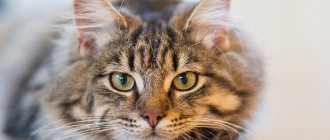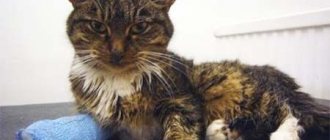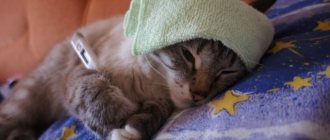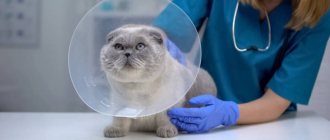Why does EEG occur?
The cause of EEG may be an allergy to flea bites or other ectoparasites, a reaction to food components, or environmental allergens, such as pollen or house dust.
Research has shown that in at least some (rather rare) cases, the tendency to develop eosinophilic skin diseases is genetically inherited. It has been suggested that genetic predisposition and environmental influences may play a joint role in the manifestation of eosinophilic skin diseases. The hypothesis that these pathologies are rarely caused by only one of the factors explains why EEG can occur during treatment or persist for several months or even years.
Prevention
You can prevent a cat disease such as eosinophilic granuloma if you carefully monitor the health of your pet. First of all, you need to protect him from possible allergic reactions, as a form of hypersensitivity to flea or tick bites, or food components. Doing this is not as difficult as it seems at first glance. It is enough to buy your cat high-quality, hypoallergenic food and regularly check the skin and treat it with acaricidal agents.
Such preventative measures, along with hygiene and vaccinations, will help the cat stay healthy, and owners will not have to worry about the fact that their beautiful pet will be disfigured by an ugly granuloma.
Types of CEG
Three types of skin lesions have been described in eosinophilic granuloma complex:
- An eosinophilic plaque is a hairless, flat, raised lesion that is often red, moist, and shiny. Plaques are most often found in the groin and armpits or on the outer thigh. These lesions are often itchy and cats may lick them constantly.
- Eosinophilic granuloma is a hairless, raised, often whitish-yellowish lesion on the skin or mouth, often with ulcers on the surface. Most often, granulomas are found on the back of the thighs (you can find the name “ linear granuloma ”), they can also occur in the oral cavity and on the tongue. Less commonly, other parts of the body (chin, paw pads, etc.) may be affected.
- An indolent ulcer is a well-defined defect (erosion or ulcer) on one or both upper lips. First, the lip swells, then an ulcer forms. The ulcer is usually painless and does not bleed.
Diagnostics
Most experienced veterinarians will be able to determine the form of the pathology only by the appearance of the cat, which will help prescribe the correct treatment. However, it is better to make a diagnosis only after a biopsy and cytological sampling. This is done in order to exclude the oncological nature of the tumor.
A prerequisite for differential diagnosis will be:
- scraping from the site of the cat's skin lesion;
- exclusion of bacterial infection using cytological examination;
- therapy against ticks and fleas;
- a special diet that will help determine whether the cat’s diet contains the allergen causing the rash.
Only after carrying out all the above manipulations can we say with confidence that the pet will be treated correctly for the type of illness that causes such a reaction in the body.
If your cat is diagnosed with EEG
Skin lesions caused by eosinophilic granuloma complex may wax and wane. If the root cause is identified and brought under control, then the lesions may disappear and not recur.
For example, it turns out that your pet is allergic to flea bites, so he is intensively treated with flea sprays or drops, and the symptoms go away. And if a cat is allergic to food containing beef protein, all types of products containing this protein are excluded from the diet.
In case of confirmed food intolerance to any food components, the veterinarian may prescribe a medicinal line of food.
For some cats, the problem may be seasonal. Seasonality is usually associated with reactions to flea, mosquito, and other insect bites or reactions to environmental allergens (such as pollen). You may need to consult a veterinary dermatologist to determine the cause of EEG.
Causes of pathology
It should be said right away that science has not established the absolutely exact factors that cause the development of eosinophilic granuloma in cats. However, statistical data suggest that there are reasons that provoke the development of this disease to a greater extent. Here they are:
- Sex and breed predisposition. Cats, due to the fact that hormonal disruptions occur more often in their bodies, are more susceptible to this disease than cats. Norwegian forest cats are particularly vulnerable to this disease, but it often occurs in other breed lines.
- Bad genetics of the pet.
- Nonspecific and food allergies in a pet.
- Dermatitis caused by tick and flea bites.
- Cat hypersensitivity.
Despite the abundance of possible causes, the owner needs to know that granuloma, in most cases, is a specific manifestation of a general or local allergic reaction to an internal or external irritant.
Drugs for the treatment of dermatitis in cats caused by EEG
Treatment is aimed primarily at finding out the cause and bringing it under control. Symptomatically used drugs to reduce itching are steroids (for example, Prednisolone) or Cyclosporine. For deep ulcers and secondary infection, antibiotics may be required.
The situation is strictly individual in each case, therefore, if the symptoms listed above appear, you should absolutely not self-medicate. It is imperative to consult a veterinarian to make a correct diagnosis. After all, even what outwardly looks like an EEG can turn out to be a more serious disease, even a malignant tumor.
Pet treatment
To accurately determine the diagnosis of granuloma in kittens, the veterinarian will examine the pet and, if necessary, conduct a microscopic examination (cytology). Based on the cytology results, the specialist will rule out other diseases with similar symptoms and perform a wet test to identify fleas and ticks. It often happens that it is impossible to determine the origin of the disease. Then complex treatment is applied. Local therapy for granuloma in cats is useless. Antiparasitic agents must be administered, regardless of whether the kitten has them or not. Only after this is it allowed to carry out anti-inflammatory therapy. Treatment is carried out mainly with the following steroid hormonal agents:
— Prednisolone; — Dexamethasone; - Triamcinolone.
Treatment is carried out for 21 days with tablets. If giving pills to a kitten is problematic, then you can replace them with injections. In this case, injections are given twice with a break of a week. Additionally, to reduce allergic symptoms, one of the following drugs is prescribed:
- Diphenhydramine; — Chlorambucil; - Cyclosporine.
In severe cases of the disease, a course of antibiotics is prescribed. After 1-1.5 weeks, the condition of a kitten with granuloma will improve significantly, but treatment cannot be interrupted. For older cats, therapy is increased if necessary to eight weeks.
How to treat a sick cat
Since the manifestations of eosinophilic granuloma are associated with systemic reactions of the body, and not with damage to the skin, the use of ointments, creams and other local remedies is not advisable. The basis of treatment is hormonal drugs:
- Dexamethasone (0.3 mg/kg per day));
- Prednisolone (2 mg/kg);
- Triamcinolone (0.8 mg/kg).
Steroids are taken in tablet form or administered subcutaneously, and the course of treatment should not exceed 3 weeks, and the exact dosage and frequency of use is determined by the doctor. As the skin lesions disappear, the dosage of the drugs is reduced and then discontinued completely.
Eosinophilic granuloma is treated with steroid hormones
Symptomatic medications (local drops and ointments that reduce itching), vitamins and antiparasitic agents are used as additional treatment.
In severe cases, when eosinophilic granuloma does not respond to treatment with steroids, immunosuppressants are used - drugs that inhibit the functioning of the immune system and reduce the intensity of its reaction to exposure to allergens.
Classification of immunobiological preparations
If formations on the skin and mucous membranes cause serious discomfort or interfere with normal eating, surgical intervention is performed - laser destruction, cryotherapy or excision of the affected tissue. Surgical treatment must be combined with conservative therapy, otherwise there is a high probability of disease relapse.
The presence of parasites is one of the factors provoking the disease
The prognosis of treatment depends on whether the provoking factor of the pathological process is identified and whether it is possible to eliminate it. If the animal's contact with the allergen is limited, eosinophilic granuloma is completely cured without complications or consequences.
Important! If left untreated, eosinophilic granuloma can develop into a malignant tumor, so at the first signs of pathology, the pet needs diagnosis and complex therapy.
Classification of immunosuppressants
Symptoms of eosinophilic granuloma
The disease is characterized by a chronic course, so the symptoms increase gradually.
With inadequate treatment or its absence, the following symptoms develop:
- lymph nodes gradually hypertrophy, become painful, become denser, and merge with nearby ones into packets;
- purulent lymphadenitis develops, the temperature rises, appetite disappears, the animal is depressed;
- if the granuloma grows in the mouth, it becomes difficult for the cat to swallow, it starves and rapidly loses weight;
- Eosinophilic gastroenterocolitis develops, digestion is upset, blood is found in the feces, and vomiting often occurs;
- numerous skin rashes appear, which merge and cover a significant surface of the body, eczema occurs;
- When counting white blood cells, eosinophilia is detected.











